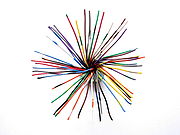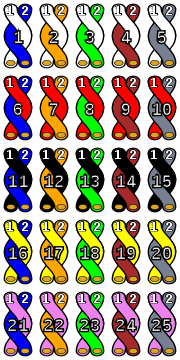
25-pair color code
Encyclopedia


Color code
A color code is a system for displaying information by using different colors. Color codes are often difficult for color blind and blind people to interpret....
used to identify individual conductors in a kind of electrical telecommunication
Telecommunication
Telecommunication is the transmission of information over significant distances to communicate. In earlier times, telecommunications involved the use of visual signals, such as beacons, smoke signals, semaphore telegraphs, signal flags, and optical heliographs, or audio messages via coded...
wiring for indoor use, known as twisted pair
Twisted pair
Twisted pair cabling is a type of wiring in which two conductors are twisted together for the purposes of canceling out electromagnetic interference from external sources; for instance, electromagnetic radiation from unshielded twisted pair cables, and crosstalk between neighboring pairs...
cables (often seen with RJ21 cables). The colors are applied to the insulation that covers each conductor. The first color is chosen from one group of five colors and the other from a second group of five colors, giving 25 combinations of two colors.
- The first group of colors is, in order: white, red, black, yellow, violet.
- The second group of colors is, in order: blue, orange, green, brown, slate.
The 25 combinations are shown to the right in the image.
The combinations are also shown in the table below showing the color for each wire ("1" and "2") and the pair number.
| Pair # | First wire | Second wire |
|---|---|---|
| 1 | White | Blue |
| 2 | Orange | |
| 3 | Green | |
| 4 | Brown | |
| 5 | Slate | |
| 6 | Red | Blue |
| 7 | Orange | |
| 8 | Green | |
| 9 | Brown | |
| 10 | Slate | |
| 11 | Black | Blue |
| 12 | Orange | |
| 13 | Green | |
| 14 | Brown | |
| 15 | Slate | |
| 16 | Yellow | Blue |
| 17 | Orange | |
| 18 | Green | |
| 19 | Brown | |
| 20 | Slate | |
| 21 | Violet | Blue |
| 22 | Orange | |
| 23 | Green | |
| 24 | Brown | |
| 25 | Slate |
The first five combinations are very common in telecomms and data wiring worldwide but beyond that there is considerably more variation.
(The color violet is sometimes called purple, but in the telecommunications and electronics industry it is always referred to as violet. Similarly, slate is a particular shade of gray. The names of most of the colors were taken from the conventional colors of the rainbow or optical spectrum, and in the electronic color code
Electronic color code
The electronic color code is used to indicate the values or ratings of electronic components, very commonly for resistors, but also for capacitors, inductors, and others...
, which uses the same 10 colors.
Sometimes each wire in a pair will have a colored stripe or rings (sometimes called a "tracer") matching the color of its paired wire. This makes it easy to identify which pair a given wire belongs to. Otherwise, to determine which pair a wire belongs to one has to note which color codes are physically twisted together.
When used for common analog telephone service, the first wire is known as "tip" and is connected to the positive side of the direct current
Direct current
Direct current is the unidirectional flow of electric charge. Direct current is produced by such sources as batteries, thermocouples, solar cells, and commutator-type electric machines of the dynamo type. Direct current may flow in a conductor such as a wire, but can also flow through...
(DC) circuit, while the second wire is known as "ring" and is connected to the negative side of the circuit, following the tip and ring
Tip and ring
"Tip" and "Ring" are common terms in the telephone service industry referring to the two wires or sides of an ordinary telephone line. Tip is the ground side and Ring is the battery side of a phone circuit. In the UK these are referred to as the 'A' and 'B' wires...
convention. Neither of these two wires has any connection to the local ground. This creates a balanced audio
Balanced audio
Balanced audio is a method of interconnecting audio equipment using impedance-balanced lines. This type of connection is very important in sound recording and production because it allows for the use of long cables while reducing susceptibility to external noise.Balanced connections use...
circuit with common-mode rejection also known as a differential pair
Differential pair
A differential pair is a pair of conductors used for differential signaling. Differential pairs are usually found on a printed circuit board, in cables , and in connectors...
.
These terms are based on the ¼″ (6.5mm) TRS connector
TRS connector
A TRS connector is a common family of connector typically used for analog signals including audio. It is cylindrical in shape, typically with three contacts, although sometimes with two or four . It is also called an audio jack, phone jack, phone plug, and jack plug...
where the "tip" of the connector is separated from the "ring" of the connector with a ring of insulation. The connection furthest from the wire is known as the tip, the middle connection is the ring and the (largest) connection closest to the wire is the sleeve (unused in this case). The female side or "socket" end is normally wired with the "tip" and "ring" configuration also, to accommodate the "plug" and maintain correct polarity when connections are established. For the female connector the connection order with respect to the wire is of course reversed.
For cables with over 25 pairs, the first 25 pairs (called a binder group) are marked with mylar ribbons using the colors of the color code starting with a white/blue ribbon, the second 25 pairs with a white/orange ribbon, and so on through the 24th binder group (600 pairs), which has a violet/brown ribbon, and forming a "Super" binder. In cables more than 600 pairs, each of the 100 pair binder groups within the 600 pair of 24 binder groups is wrapped with a mylar binder ribbon, or string, matching the "tip" colors of the color code, starting with white. The pattern then starts over with the first 25 pair group as white/blue, and continues indefinitely, in multiples of 600 pairs or parts thereof. For example, a 900-pair cable will have the first 600 pairs in 24 groups of 25 pairs in a white binder, and the remaining 300 pairs in 12 groups of 25 pairs wrapped in a red binder.
Some cables are "mirrored" or "clocked" with a pattern that is known throughout the telephone industry. Starting with the first binder group in the center, the technician counts the cable's groups in a spiral direction depending on the location of the Central Office or switch. If looking at the cable's core and the switch is in that direction, you count the groups counter-clockwise. If the cable is the "field side", you count the groups clockwise. There are indicators on the mylar ribbons to know where to begin for each layer and a diagram for the different cable sizes should be readily available for reference.
Other color schemes are sometimes used for outdoor cables, particularly outside the US, but this color code is common for aerial and underground cables up to several thousand pair in North America.
Mnemonics
The first group colors can be remembered with the mnemonic: Why Run Backwards You Varmint (White, Red, Black, Yellow, Violet)Another mnemonic for the first group is: "Winchester Rifles Bring You Victory"
The sequence of second group colors can be remembered with the mnemonic: BOGBRuSh (Blue, Orange, Green, BRown, Slate). (This mnemonic is attributed to a British radio engineer, "bog brush" being a colloquial British term for a toilet pan cleaning brush
Toilet brush
A toilet brush is a domestic implement designed for the cleaning of the lavatory pan. The modern plastic version was invented in 1932 by William C. Schopp of Huntington Park, California, USA and later patented in 1933 by The Addis Brush Company....
.)
The old-style mnemonic as mentioned above, for the second group of colors was, "Boy On Girl Brings Satisfaction."
Another mnemonic common for the second group colors is: Bell Operators Give Better Service.
Another mnemonic device for the second group is "The sky is blue, the sun is orange, the grass is green, the dirt is brown, and the slate is slate."
Another mnemonic for both the Tip & Ring colours: "We Ride Big Yellow Vans Because Old Guys Break Stuff"

